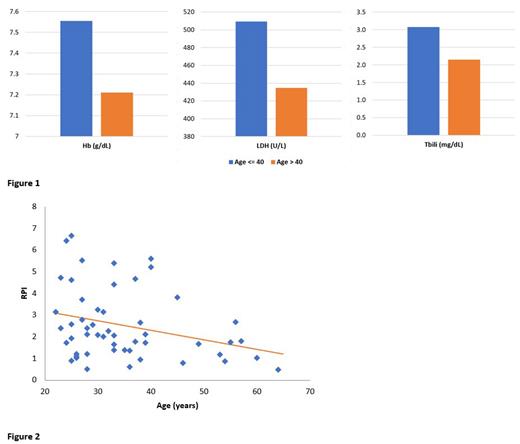INTRODUCTION
In the United States, life expectancy for adults with sickle cell disease (SCD) has improved over the last several decades and providers are now encountering increasing numbers of patients in the fourth, fifth and sixth decades. One notable feature of older SCD patients is lower ‘steady state’ hemoglobin (Hb) levels. Although it is well established that lower Hb levels are associated with increased adverse outcomes including pulmonary hypertension, stroke, cognitive decline, acute chest syndrome, frequency of vaso-occlusive crisis and shortened survival, a full understanding of the mechanisms accounting for the more prevalent and severe anemia in older SCD patients remains to be elucidated. Involved factors may include the long-term effect of chronic hemolysis, age-associated increased inflammation, progressive renal insufficiency and an age-related decline in nutritional adequacy. Despite lacking a uniform explanation for anemia applicable to individual SCD patients, it remains a management goal to optimize Hb level as possible within constraints associated with the development of secondary hemochromatosis. We postulate that the pathways to anemia in SCD patients may change with advancing age and that a better understanding of these pathways may result in a more directed intervention for the older sickle cell patient.
METHODS
Adult patients visiting Inova Adult Sickle Cell Center over a 6-month period (January through June 2023) with Hb levels below 9 g/dL were evaluated by a contemporary hematologic panel that included complete blood count with differential, reticulocyte count, comprehensive metabolic panel (included total bilirubin and creatinine), and lactate dehydrogenase (LDH). The reticulocyte proliferation index (RPI) was determined utilizing a readily accessible calculator (MedCalc) and a univariate regression analysis was performed for RPI against age. An RPI of < 2 was considered evidence for hypoproliferative anemia.
RESULTS
Of the 139 unique adult SCD patients visiting our clinic in this 6-month period, 60 had Hb levels equal to or below 9 g/dL. Of these, 8 patients had serum creatinine levels ≥ 1.5 mg/dL and were considered to have hypoproliferative anemia based on renal insufficiency. Among the remaining 52 patients, the mean age was 34.9 years, mean Hb was 7.49 g/dL and the mean RPI was 2.52. In patients with age ≤ 40 years, mean RPI was 2.74, compared to mean RPI of 1.61 in patients with age > 40 years. The mean Hb was 7.55 g/dL vs 7.21 g/dL mean total bilirubin was 3.08 mg/dL vs 2.15 mg/dL and mean LDH was 509 U/L vs 434 U/L in these two age groups (Fig 1). Regression analysis indicated that an increase in age corresponded to a reduction in RPI at 95% confidence level (Fig 2; regression coefficient: -0.04; 95% CI: -0.08 - -0.003; p-value: 0.03).
CONCLUSION
From the data we gathered, we conclude that despite chronic hemolysis in sickle cell disease, low RPI and ineffective erythropoiesis are evident to some extent in the majority of adult SCD patients even in the absence of renal failure and this significantly increases with age. Older patients with SCD are more likely to have ineffective erythropoiesis. We speculate that this may be evidence for age-associated bone marrow failure not unlike myelodysplasia (MDS) which occurs with increased frequency in the general population with advancing age. If future studies confirm disordered erythropoiesis, clonal hematopoiesis, or other markers of MDS, novel treatments known to be effective in patients with MDS may be examined in selected anemic SCD patients.
Disclosures
Ershler:Novartis: Other: Advisory board; Responder's office, Speakers Bureau; Pharmacosmos: Other: Advisory board, Speakers Bureau; Pfizer: Other: Advisory board, Research Funding, Speakers Bureau; Global Blood Therapeutics: Other: Advisory board; Responder's office.


This feature is available to Subscribers Only
Sign In or Create an Account Close Modal